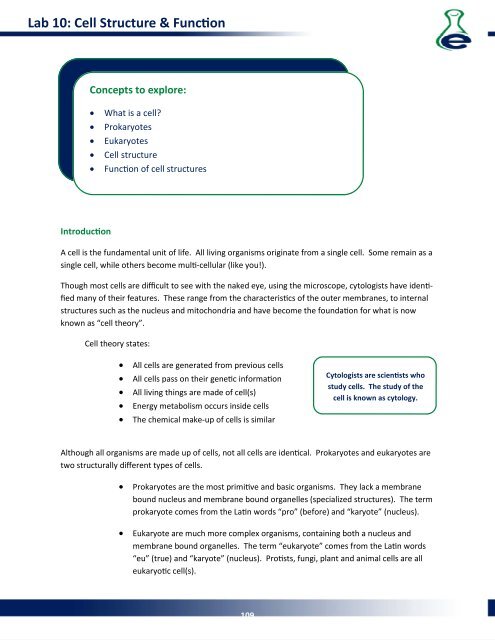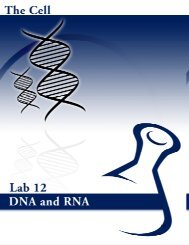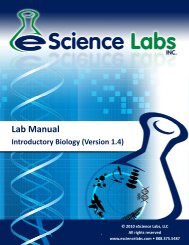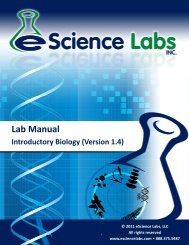Lab Manual - eScience Labs
Lab Manual - eScience Labs
Lab Manual - eScience Labs
Create successful ePaper yourself
Turn your PDF publications into a flip-book with our unique Google optimized e-Paper software.
<strong>Lab</strong> 10: Cell Structure & Funcon<br />
Concepts to explore:<br />
• What is a cell?<br />
• Prokaryotes<br />
• Eukaryotes<br />
• Cell structure<br />
• Funcon of cell structures<br />
Introducon<br />
A cell is the fundamental unit of life. All living organisms originate from a single cell. Some remain as a<br />
single cell, while others become mul-cellular (like you!).<br />
Though most cells are difficult to see with the naked eye, using the microscope, cytologists have idenfied<br />
many of their features. These range from the characteriscs of the outer membranes, to internal<br />
structures such as the nucleus and mitochondria and have become the foundaon for what is now<br />
known as “cell theory”.<br />
Cell theory states:<br />
• All cells are generated from previous cells<br />
• All cells pass on their genec informaon<br />
• All living things are made of cell(s)<br />
• Energy metabolism occurs inside cells<br />
• The chemical make-up of cells is similar<br />
Cytologists are sciensts who<br />
study cells. The study of the<br />
cell is known as cytology.<br />
Although all organisms are made up of cells, not all cells are idencal. Prokaryotes and eukaryotes are<br />
two structurally different types of cells.<br />
• Prokaryotes are the most primive and basic organisms. They lack a membrane<br />
bound nucleus and membrane bound organelles (specialized structures). The term<br />
prokaryote comes from the Lan words “pro” (before) and “karyote” (nucleus).<br />
• Eukaryote are much more complex organisms, containing both a nucleus and<br />
membrane bound organelles. The term “eukaryote” comes from the Lan words<br />
“eu” (true) and “karyote” (nucleus). Prosts, fungi, plant and animal cells are all<br />
eukaryoc cell(s).<br />
109
















